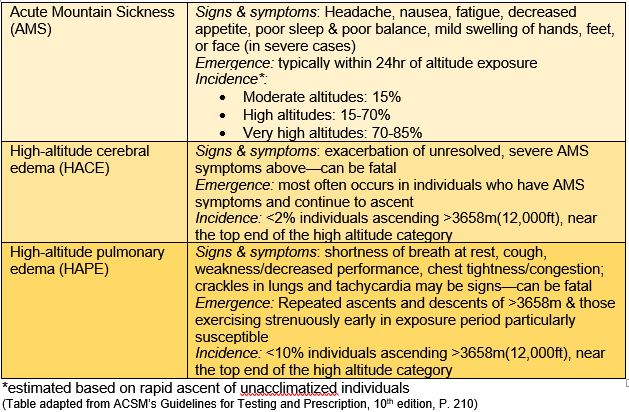The Physiologist Files: Altitude (Part 3 of 3)
Author: Hillary J. Greene
Go to Source
The OCR championship season is upon us. This brief three-part series takes a look at environmental factors that can affect an athlete’s performance. This final entry examines the effects of altitude in terms of exercise and performance. Read on to discover the physiological effects of altitude, what to expect with elevation, and how to adapt.
Under Pressure
Let’s first be clear what is meant by altitude in terms of athletic performance. In general, most individuals experience the effects of altitude at 1200m (3937ft). ACSM sets the following parameters in determining levels of altitude:
You’ve probably heard the phrase “the air is thinner” implying that there might be less oxygen at altitude. This isn’t exactly the case as the percentage of oxygen remains the same at altitude versus sea level (20.93%). Rather than oxygen being less available, the “thinner” part of this phrase refers to the partial pressure of gases at altitude. Allow me to explain…
Pressure Points
These are the key components contributing to the feeling of “thinner air” at elevation:
- Atmospheric pressure: Barometric pressure drops as altitude increases giving the air the perception of being less dense—this is due to a fewer number of molecules of the atmospheric gases (O2, CO2 & N2).
- Partial Pressure: Partial pressure refers to the pressure of each gas in a mixture. Gas moves from an area of higher partial pressure to an area with lower partial pressure; the greater the partial pressure difference between the two areas (air and lungs), the more rapid is the movement of gases.
- Oxygen Saturation: Further, the diffusion of gas into a liquid—blood in this case—is affected by the decrease in the partial pressure of O2 (PO2) which also affects alveolar PO2, the site where gas is exchanged between lungs and blood. Lower O2 saturation of hemoglobin, the blood’s O2 transporter, means delivery of necessary oxygen to working muscles is affected in kind.
- At sea level, hemoglobin is typically at least 96 – 98%
- Elevations of 2300 – 4000m saturation can fall to between 88 – 71% (Kollias & Buskirk, 1974).
- [Lack of] Humidity: Air at altitude is less humid than that at sea level. This means your body must work to humidify breathed air, which contributes to further water loss at altitude.
Performance Impacts
So what does all this mean in terms of exercise and competition at elevation? Short, single bursts of energy—think sprinting—is generally not affected by the lower partial pressure of O2 since bouts of this intensity are not dependent upon oxygen (anaerobic performances = without oxygen). That said, repetitive high-intensity bouts might be affected given the slowing of ATP regeneration in a state of hypoxia (decreased PO2 in the blood) (Haseler et al., 1999; Haseler et al., 2004; Haseler et al., 2007). In general, the longer the event, the greater the impairment due to elevation; similarly, the higher the elevation, the greater the impairment as well. For events that last roughly 2-5 minutes, elevation might not become a factor in performance until ~1600m+ (5249ft) elevation. Those events lasting between 20-30 minutes may begin to see impairment at altitudes lower than ~1600m.
Referring to the pressure points above, this is how your body responds when exposed to altitude:
- Heart works harder: Lower O2/L concentration means more blood must be pumped to compensate; this means at the same given submaximal intensity at sea level, your heart rate will be higher at altitude. Until acclimated, the intensity of exercise must decrease accordingly to stay in the target heart rate zone.
- Lungs work harder: As altitude increases the presence of O2 molecules decreases. That means a runner has to work to breathe an increasing amount of air with each breath to take in the same amount of O2 at sea level.
- Feel the burn quicker: Since O2 is not as readily available to the working tissues, hypoxia may result in normal aerobic (oxygen-dependent) performances shift to anaerobic metabolism (non-oxygen dependent) which increases lactate production (Reeves et al., 1992). This is often associated with that burn you feel in your muscles as the lactate works to clear hydrogen ions causing that burn.
- Hydration is critical: Less humidity + greater exertion sets us up for the threat of dehydration.
Live High
Altitude-related Injuries
Illnesses susceptibility increases when one ascends rapidly to the high or very high altitudes in the table above. Prior history of illness at altitude, prolonged physical exertion and dehydration all increase susceptibility. Disclaimer: I am a certified Exercise Physiologist—not a doctor—so please consult a medical professional when diagnosing and treating altitude-related illness.
Gradual acclimatization is the best prevention of such illnesses. Upon development of altitude-related illness symptoms, the preferred treatment is return to a lower altitude. Again, consult a physician for appropriate, comprehensive strategies if an altitude-related illness is suspected.
Acclimatization
The best way to decrease susceptibility to illness and prepare for an event is to be exposed to the correct altitude. If competing in the high or very high altitude range, the staging approach may be best which promotes gradual adaptation by increasing elevation over multiple days’ exposure before moving to the next level. This means spending 3 days or so in a moderate altitude before moving into the higher altitude zone.
Acclimatization period: Short stays of 3-7 days at a moderate altitude will reduce susceptibility to sickness at higher zones. If you are looking for improvement to physical performance, this means an exposure period of 6-12 days prior to an event.
Recall from above, however, that events lasting between 20-30 minutes may begin to see impairment at altitudes lower than ~1600m. So while the top four events are technically classified in the “low” category, racers may experience the effects of altitude given these events are longer than that 20-30 minute span mentioned.
Adaptation
Continued exposure over time to a given elevation will eventually yield adaptation. Here’s what to expect:
- Decreased heart rate at rest and with submaximal exercise—returning to the normal heart rate at sea level
- Increased percentage of arterial O2 saturation means more oxygen is shuttled to the working muscles making the work more efficient and feel easier than at initial exposure
Training Tips
If you’re traveling from sea level to an event at higher altitude, keep in mind that rapid ascent to an altitude of approximately 4300m (14,107ft) may result in symptoms of AMS lasting for a couple of days. Here are tips to manage training during the initial exposure period:
- Avoid excessive voluntary physical activity. This means reduce the intensity and/or duration of your endurance training.
- Strap on your heart rate monitor. This will help ensure you stay in your intended heart rate zone. If a heart rate monitor is not available, use perceived exertion. A 9:00 mile pace will feel more difficult at elevation than at sea level. It’s okay and recommended to slow down while your body adapts.
- Plan ahead and stick to a hydration plan. More effort is required to humidify air for your lungs and sweat will evaporate more quickly.
- Exposure is superior to a hypoxia mask when it comes to inducing functional adaptation. Though if an athlete has never been exposed to the feeling of “thin air,” a mask may help mentally prepare prior to travel.
As with the other Physiologist Files, I leave you with the primary takeaway of caution when competing at altitude. I will be the first to admit that even with all my study, I did not expect to be so completely taken aback by my first adventure to the mile-high city. Though Denver sits smack dab in the middle of that moderate elevation range at 1560-1730m (5130-5690ft), I was completely unprepared for the altitude sickness symptoms of nausea, fatigue, decreased appetite, and poor sleep to creep in. Take it from me—no amount of endurance training at sea level will prepare you to fight your physiology at altitude. You are not weak—you are adapting.
Thanks, friends, for hanging in for this three-part science-heavy series. Please let us know if you enjoyed the series and would like to see more similar or technical articles in the future!
For tips training for mountain versus a stadium, see MRG Crew, Julie Palmar’s article. To read more about the sufferfest that is a combination of cold and elevation, check out Kya Michelle’s recap of the 2019 Spartan Big Bear Sprint.
The post The Physiologist Files: Altitude (Part 3 of 3) appeared first on Mud Run, OCR, Obstacle Course Race & Ninja Warrior Guide.




